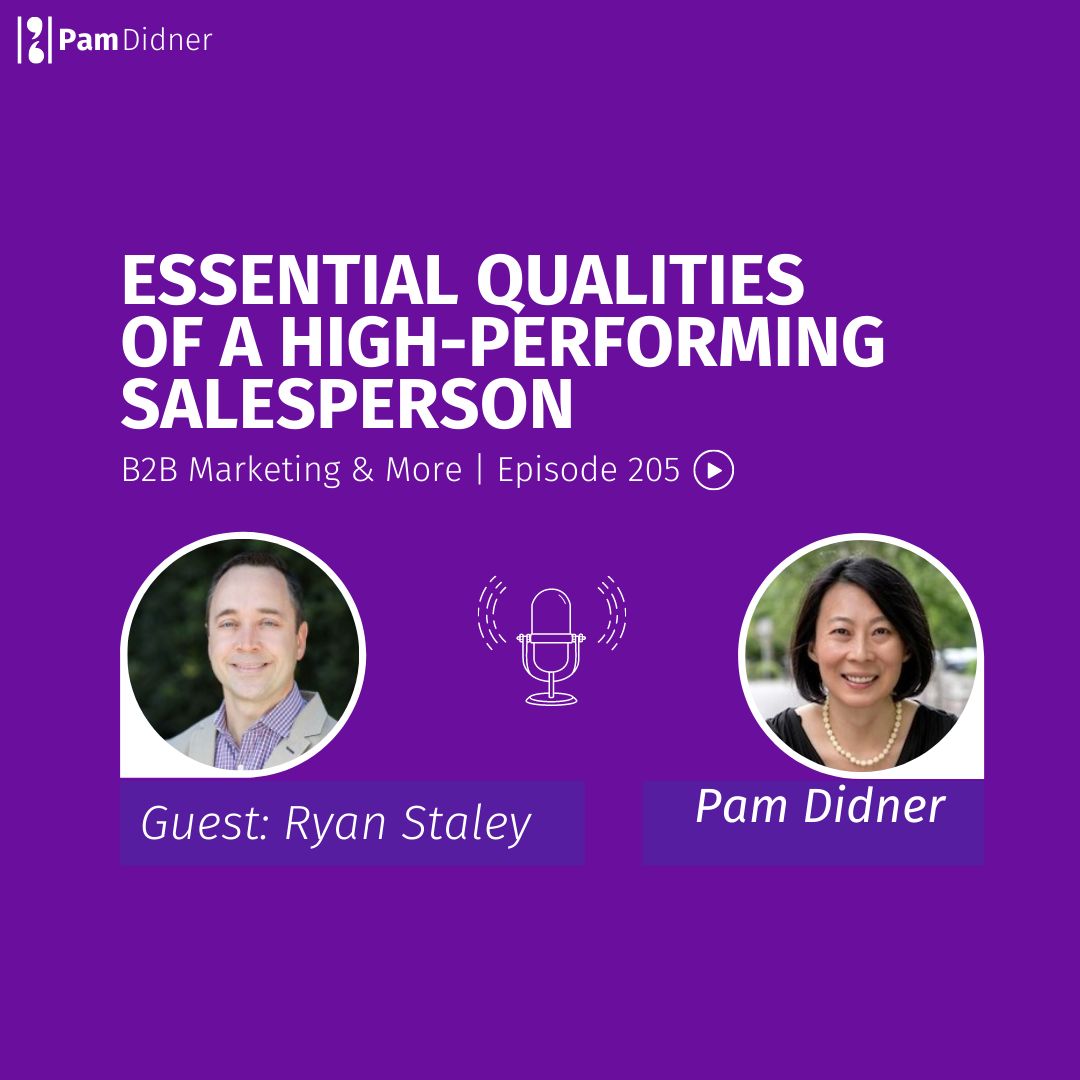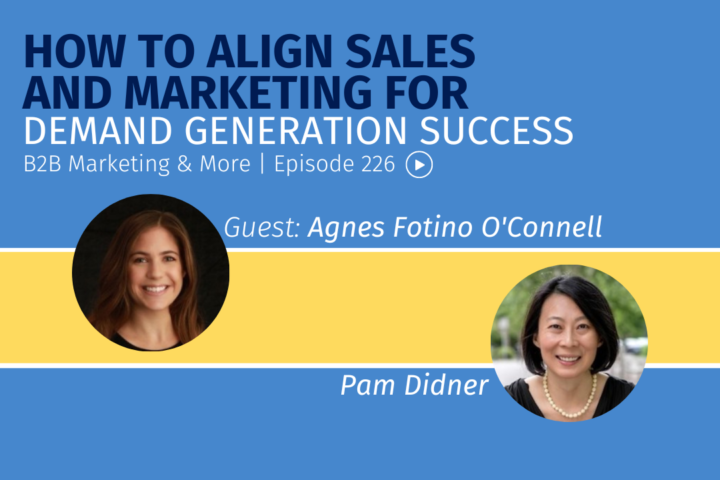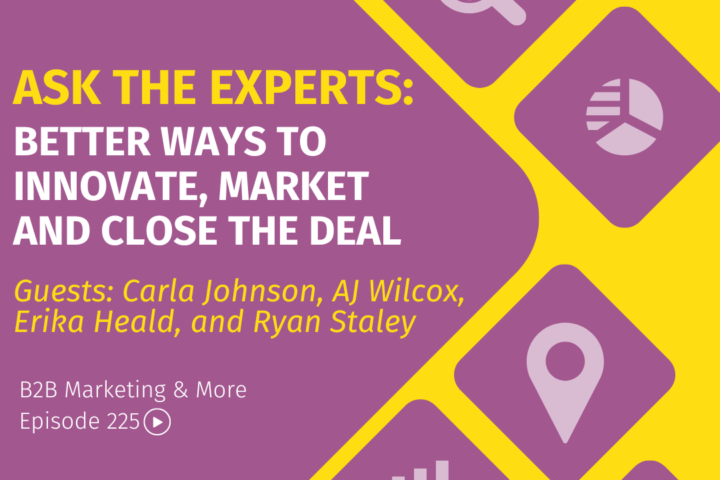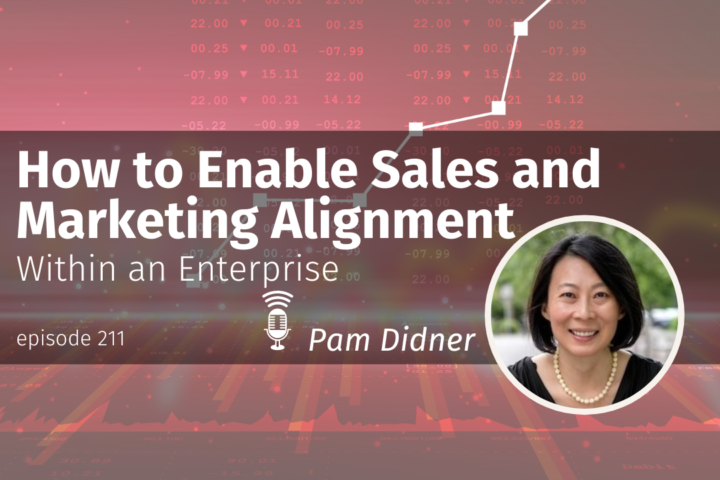
A big hello from Portland, Oregon. Welcome to another episode of B2B Marketing & More.
My guest is a sales professional, Ryan Staley, the CEO and the founder of Whale Boss. Ryan is a fantastic and high-performance salesperson, he helps founders and revenue leaders implement 7 and 8 Figure sales operating systems in less than 3 months.
Today, we talk about the essential characteristics of effective salespeople.
In this episode:
- What are the tips and tricks to capturing big clients?
- How to understand your customer and focus on the company’s needs?
- Cold calling tips: how to reach out to the prospects you don’t know and get them interested in having a conversation?
- In what ways sales engagement was changed by pandemic?
- How can salespeople adapt to the new circumstances?
- What is the best way to start a conversation with a prospect?
- How can B2B marketers better support sales?
- What are the characteristics of effective salespeople?
- What are some of the salespeople’s pet peeves that marketers should be aware of?
Quotes from the episode:
“Cold calling could fit in a lot of different buckets. That could be social interaction that can be picking up a phone, that could be texting, that could be emailed, that could be direct messaging. And so there’s a lot of different channels that you do to make that a reality.”
“One of the cool things that you could do is try and connect with that person emotionally about something, every single call you have with them. What I look at is a bit like layering in finding a little more about the person, a little deeper, every single communication touchpoint that you talk to them live.”
—————
Enjoy the podcast? Subscribe to the show on your favorite podcast platform, leave a 5-star review and subscribe to Apple Podcasts.
If you prefer watching a video, I also have a YouTube Channel; check it out and subscribe.
If you want to chat, reach out to any social media channels or email me at hello@pamdidner.com. You can also join my Facebook community: Build Your Marketing Skills to Get Ahead. When you join, you get a free Starbucks on me. You can go to the Announcement tab and click on the barcode of the gift card.
To expand your knowledge about the characteristics of effective salespeople, check out some of my previous podcast episodes, blog posts, and video.
Podcast episodes
Ask the Experts: Proven Tips for Sales and Marketing Alignment
Where Marketers Can Better Help Sales Boost Revenue
Social Selling Dos and Don’ts for Your Sales Team
Blog post
Sales Enablement: How To Boost Your Communication with Sales in 6 Easy Steps
How The Best Sales Reps Set Themselves Apart From Competition
Video
How To Facilitate Sales and Marketing Integration within a Large Enterprise
TRANSCRIPT
A big hello from Portland, Oregon. Welcome to another episode of B2B Marketing & More. I’m your host. Pam Didner. Today I am talking to not a marketer but a sales professional. Ryan Staley is the CEO and the founder of Whale Boss. And he’s a fantastic and high-performance salesperson. So welcome, Ryan.
Ryan Staley: What’s happening? Happy to be on the show. Thanks for having me. I’m Pam.
Pam Didner: All right, Whale Boss. What a wonderful name. Can you tell me where your company’s name is from?
Ryan Staley: Yeah, so it seems like a natural progression because essentially, uh, over the last, I don’t know, six and a half years that I was in the corporate world, essentially, I had to grow a team, and they’re like, “Hey Ryan, we want to move upmarket and create a team.” And I’m like, “Okay, what’s the go-to-market strategy?” “Go figure it out.” I’m like, “what’s the sales playbook?” So like, “go figure it out. “I go, “where’s my team?” They’re like, you don’t have one.”
Pam Didner: Go figure it out.
Ryan Staley: Right. I had to find a way. It was a very good company but very scrappy resource availability. And so what happened is we grew from adding large customers. So we added, I think, close to over 35, $500,000 plus contracts—a $20 million contract. And we grew the business unit from zero to $30 million in annual reoccurring revenue in six years with only four salespeople.
So I’m like, okay, well, what I want to do for my future when I left, there is help companies close these really big deals and implement the sales systems to do that. So that’s where the name came from.
Pam Didner: So you capture whales and big whales all the time. And that means the big deals and big dollars. So you have been closing half a million dollars of deals, $20 million, et cetera. And can you share with us some of the tips and tricks to do that with us?
Ryan Staley: Yeah, no problem. That’s, I don’t wanna say it’s easy, but it’s easy for me to kind of codify that for you and the listeners. So really it, when it comes down to is like, I would say most people make the mistake of focusing on what just the company wants. Okay.
Pam Didner: You’re talking about what the customer wants? Is that what you mean?
Ryan Staley: What the customer’s company wants, not the customer as an individual. And here’s what I would tell you is like, I’ve done the entire gamut. You know, half my career. I was a salesperson for half my career. I was a sales leader a vice president of strategic accounts when I left. And, like the key things people are trying to sell, let’s say a larger deal. And one of the things that a lot of companies where people focus on are sales reps or sales leaders is like, “Hey, the ROI for the company is this.
They’re going to say millions of dollars are going to do this.” But one of the things that they forget is, okay, how is that person evaluated? What kind of KPIs are they evaluated with? You know, at the end of the year, when they sit down with their boss and you’ve just finished, are they going to get a bonus or are they going to get demoted? And did they hit on what they were supposed to? So that’s the tangible business side of it.
But then also it’s like, what does that solution going to do emotionally for that person you’re selling to? Because logic is how people make decisions. Emotion is what creates action. And so those two kinds of triggers are key things to look at when you’re trying to work and sell. So I would say that’s number one. Number two is just asking good questions. Okay? That’s one of the advantages that sales have over marketing.
We can physically talk to the people versus looking and getting feedback from communities and social. You can talk to the people and ask them specific, tangible questions on the outcomes they want, what’s bothering them, all those details. So I would say just being a ninja at asking good thought-provoking questions that make people question thoughts that they’ve had previously.
Pam Didner: Oh, you brought a very, very good point. The number one thing you are talking about. I love it very much. You said it is not what the company wants you to focus on: what will impact decision-makers or the prospects you talk to specifically? You kind of take care of their needs. And, uh, you also take care of in terms of how they will be evaluating. So, and then, you know, on the marketing side, it does something similar. It’s like understanding your customers. Well, I think you are doing that as a salesperson.
On top of it, I love, love, love you hit the core in asking good, good questions. When you ask a thought-provoking question, you get people, do things and say, “you know what? I didn’t think about that. Now, if we take that into account, is the solution that we are evaluating right now making a lot of sense?” So I love that. That’s great.
So with that being said, my next question is cold calling is very hard. When you get to know a prospect and start asking thought-provoking questions, that’s great because you got, you know, them already, but cold calling is very hard. So how do you go about doing that? Reaching out to the prospects you don’t know to get them interested in talking to you?
Ryan Staley: Yeah. So, it’s a little different now because I’m a founder. So, I do elements of cold calling. Cold calling could fit in a lot of different buckets. That could be social interaction that can be picking up a phone, that could be texting, that could be emailed, that could be direct messaging. And so there’s a lot of different channels that you do to make that a reality.
And so what I would say is that the number one most important thing to do, cause like it’s funny Pam, my first job, was an inside sales position. So I had to make,
Pam Didner: I know how hard that job is. I was in inside sales for a while. Man, it is a hard job.
Ryan Staley: Yeah. I mean, I made like 250 dials a day. I mean, this was a long time ago. So, I would tell you that the number one, most important thing is relevancy to what stage that company or person is in. And so I would start with relevancy is probably the most important thing. Um, and then the other is like, don’t be spammy. (both laugh) I mean, like, I’ll tell you this, I, I just got this today, and it happened. And I could tell when I’m on like an auto sequencer from someone.
Pam Didner: Me too. I can immediately tell, you know, my radar is on. I was like, “yeah, that’s an auto-sequencing email.”
Ryan Staley: Yeah. Which, which, Hey, I realize there’s value in it, and I get why people do it. And, and, and like, but today what happened is the guy’s like0 The person reached out and like, “Hey, we have this new SaaS solution. This is what it does. We’re interested in your feedback.” And then they send me the same kind of robotic message. And then they send to me again, and I go, “Listen, I have no idea what you’re talking about or like what the outcome you’re looking for. Please take me off the sequencer.” Like, I say that in the response.
I would say relevancy. Relevancy to the stage where people are at with what they’re doing. What their benefits are, and I’ll give you a specific example. So there was a deal that my team was working on, and the reps were full cycle. And so they had a prospect. Um, they didn’t have an SDR team, or we didn’t have any marketing support. So they had to find a way to get into these big Fortune 1000, Fortune 500 companies. One of the companies trying to get into was Walgreens, like Fortune 10. So they’re even bigger than big. Right?
What happened was Walgreens has recently merged with Boots–this was maybe four years back. They just merged with Boots. Their CEO and chairman identified in their press release that the number one priorities and outcomes of the merger are gaining “synergies”; they’re going to get $500 million in synergies from merging the companies. And what they were saying is they’re taking $500 million out of business in costs. One of the levers we hit on to get in there was to link to the CEO’s initiative.
Pam Didner: Because it’s top-down, it’s coming from the management. It’s top-down.
Ryan Staley: Exactly, exactly. And so, so that’s a good example of how to hit on that. You could look at 10 K’s. You could look at other financials if you want; the letter to the CEO in the annual report. That doesn’t scale for smaller and mid-market companies. So there are different strategies, but that’s what I’d recommend for big, big deals.
Pam Didner: I love it. So the bottom line is I think the biggest takeaway from your answer is if you do cold calling, yes, it is very hard. It’s not an easy job, but you have to do your homework. You have to do your research and find a way to talk to them and then make that relevant. I think that’s, that’s the key answer. Excellent.
All right. The next thing I want to ask very quickly is, have sales engagements changed during the pandemic? You know for the longest time, um, the salespeople, they prefer face to face. They prefer in-person visits. We can do much of that during the pandemic. How did you adapt?
Ryan Staley: Once again, my role is slightly different now than it was, but I talk and consult with people. I’m head of a sales community, a region in there. So I talked to people, and one of the things that I’ve, I’ve kind of coached people on, which is funny how things come full circle. The first, like a big deal, was $200,000 a month that I ever got as a sales rep for the first, I don’t know the majority of the sales cycle. I could never, I wasn’t allowed to meet with a person because of travel restrictions. So like, I had to do it all over the phone, and this is for like Zoom or video conferencing or anything.
And so, this strategy is super simple. Anybody could do it. If you’re in a sales process and you’re selling, even if you’re in mid-market, like let’s say it’s a deal $40,000, average contract value or annual contract value 30 or 20. Something that’s not just like a one-call close type deal. Right.
Pam Didner: It requires multiple follow-ups.
Ryan Staley: Yeah, multiple touches. And so one of the cool things that you could do is try and connect with that person emotionally about something, every single call you have with them. What I look at is a bit like layering in finding a little more about the person, a little deeper, every single communication touchpoint that you talk to them live.
That’s is critical because pre-pandemic that’s what happens at the lunches, the dinners, the in-person meetings…
Pam Didner: The wine and dine.
Ryan Staley: It could be wine; it could just be coffee. It could just be anything; it’s just connecting with people on an emotional level. And so what’s happening? I see people jumping from Zoom call to the Zoom call to Zoom calls to Zoom call. They’re not taking the time to understand what lights that person up, um, at an individual level. Or why they’re doing what they’re doing. They’re just focused on business, business, business, business, and then they just get looked at as a number when they need to get deals done, things go dark. So there’s a lot of really, really big problems that happen if you don’t develop that relationship, even if it’s remotely only.
Pam Didner: uh, before the pandemic, the salespeople can do a lot of in-person visits. They can have a coffee; they can take the client out and, uh, you get to know the person through a very informal social gathering. And the, you need to convert that into, to do something similar, but in the virtual communication. It sounds like you are suggesting, during the call, to make an effort to find out who that person is as an individual. And then try to connect at the individual and emotional level, to understand that person, not necessarily what they do or try to accomplish as a business professional.
Ryan Staley: Yeah. And like a really specific example. This is the number one question that I coach people to say. As a VP, I would have to pop into deals and find a way to connect with someone within minutes after never meeting them after the wrap. And I, like, I kind of cracked the code on it. And one of the key questions you want me to share with you is that cool?
Pam Didner: Sure. That’d be great.
Ryan Staley: Okay. Is, is basically like, “Hey, um, what’s the number one thing you like to spend your time on outside of work?” Okay. And what people mostly say as well, kids or family, right? They’ll just say, “uh, I just spent all my time on kids or family.” It’s like, okay, well, if you’re not spending time with kids or family, what’s the number one thing you’d like to do like for fun or as a hobby or whatever? And like, Pam, I can’t tell you the stories that get unlocked from. There’s an executive at a multi-billion dollar company who asked that question. He went on like a half-hour discussion about how passionate he was about photographing waterfalls and how he took two vacations a year to see different waterfalls across the world. He had a separate Instagram account.
And so it just really opens up that person’s passion and allows you to connect with them as a real human being, as opposed to just adding a business transaction level. And then there are ways where you could stack other things on top of that. If you’re doing this every step along the way, you have five interactions with them. That’s a completely different experience after five or six times versus someone who just goes through the business motions of it.
Pam Didner: Yes. So it’s kind of like, how do you mix not the personal questions along with a business question and the key back conversation going?
Ryan Staley: Yeah, I think it’s, I mean, you know, there’s the standard sometimes downtime, like when you first start or towards the end where there are opportunities to do that. You know, so it’s always easy, and it depends; there are different flows to it, right? Now and then, there’ll be a person like: “we’ll just get to this, get to this, get to this.” Right. But what I will tell you is there’s a lot of people that aren’t like that.
I mean, I would say the majority, like 90% plus, isn’t just getting to it; they’re open to talking and want to enjoy conversations. Especially because they’re in front of the computer a lot. It’s not as much as it was at the beginning of the pandemic–but there are a lot. So they like to enjoy the time in front of it as well. So people are open to the conversations.
Pam Didner: Understood. So obviously, that kind of engagement and that kind of personal interaction needs to be done by sales. And, um, if you have marketing people supporting you, they cannot do that on your behalf. From your perspective, what kind of help do you usually receive or not receive from marketing? Or can you share with us or the B2B marketers who support sales what they can do better to support their sales team?
Ryan Staley: I think, um, the number one thing that they could do is just make sure they’re in alignment. I heard Kyle Lacy talk about this–he’s the CMO at Lessonly. And one of the things that he kind of identified as having almost a joint service level agreement between marketing and sales.
Pam Didner: I talk about that in my workshop as well.
Ryan Staley: Oh, perfect. Okay. So yeah, like I would say alignment on that. The other thing I would say, too, is that there are many cool tools that you can use to send gifts. I think like support for that. At the same time, one of the women I’ve become friends with through Pavilion is EJ Selling, and EJ does field marketing. She just started at 6Sense. She was at Aperio before. And she does like virtual experiences with different tastings and different experiences. Things like that are
Pam Didner: Very much uh it’s account-based uh, customer events.
Ryan Staley: Exactly. Exactly. Yeah.
Pam Didner: Very good. Excellent. So one last question. What are some of the salespeople’s pet peeves that we should know? Like if you guys are sometimes in the zone and we should not be talking to you, or you guys are working on a big deal and then you know, everybody in the situation room, and there is a war plan.
Ryan Staley: Um, I would, I think probably be the biggest one that I’ve seen when, when it comes to sales and marketing is sending out a bunch of content that isn’t anywhere near a line, what the sales messaging is or what’s, what’s a priority.
Pam Didner: I hear you. Yeah, that’s a great point. And, uh, in my workshop, I usually talk about content mapping. You need to map the content to sales stages–understand how salespeople sell. And then, uh, also the type of question they tend to address a different sales stage. You customize the content specifically for that needs.
All right. Very good. I only have three minutes of your time. I want to ask you one silly question. So what is the show that you are binge-watching right now, and do you recommend it?
Ryan Staley: I’m not like a huge, super big binge-watcher, but there are two shows on my radar. One is like totally stupid humor, called The Righteous Gemstones.
Pam Didner: Really, I didn’t know that. (laughs) Usually, I know the show that people mention.
Ryan Staley: It takes a unique person to enjoy it. It’s kinda like, um, from the Kenny Powers world. And it is Danny McBride, John Goodman, and it’s a joke on the mega-churches with a preacher and his family; it’s so ridiculous and so over the top, and it’s like a half-hour show. So it’s pretty light. It doesn’t require a lot of brainpower. Um, and then another one that I think is pretty cool, but I haven’t checked it out is Ozark, the new season of Ozark.
Pam Didner: No, no, I haven’t. I haven’t seen that either. So I will check that one out. Excellent. Ryan, thank you so much for coming to my show and talking about the perspective of being a salesperson and the support that the marketer can do to help from your perspective.
Ryan Staley: No problem, Pam. Thanks for having me on.
Pam Didner: If you liked the episode, like the topics we talked about at the B2B Marketing & More, please subscribe and comment below. Love to hear from you. All right. Take care. Bye



